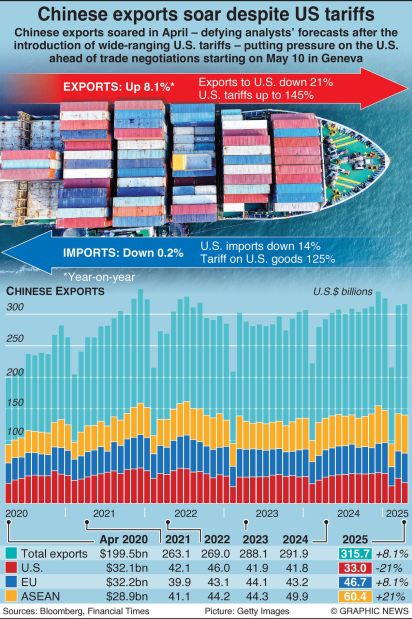CHINA’S exports beat forecasts in April, buoyed by demand for materials from overseas manufacturers who rushed out goods to make the most of US President Donald Trump’s 90-day tariff pause.
The world’s two largest economies have been locked in a bruising tit-for-tat tariff war and businesses on both sides of the Pacific will be looking for some kind of resolution at closely watched trade talks in Switzerland this weekend.
Customs data yesterday showed outbound shipments from China rose 8.1 per cent year-on-year in April, beating a forecast 1.9pc increase in a Reuters poll of economists but slowing from the 12.4pc jump in March.
Trump announced sweeping “reciprocal tariffs” of 10pc on April 2, before offering a pause for most countries while the White House worked on multiple trade deals. China, however, was excluded from the reprieve and singled out for levies of 145pc, kicking off a protracted cat-and-mouse game that has rattled global markets and upended supply chains.
Chinese manufacturers had also been front-loading outbound shipments in anticipation of the duties, but are now banking on ice-breaker tariff talks between American and Chinese officials in Geneva today.
Imports fell 0.2pc, compared with expectations for a 5.9pc drop, suggesting domestic demand may be holding up better than expected as policymakers continue to take steps to prop up the $19 trillion economy.
“The ASEAN countries are speeding up their production to meet the July deadline, the 90-day negotiation break. Their production is highly reliant on China’s exports in raw materials and industrial inputs, so China’s exports got support,” said Dan Wang, China director at Eurasia Group.
“Over the next two months, China’s exports could continue to be strong due to industrial capacity relocation, but the trade data could deteriorate quite quickly if the 145pc tariffs on China are still in place and ASEAN countries’ talks (with the Trump administration) don’t make progress,” she added.
Exports to Southeast Asian countries rose 20.8pc in April.
China’s exports to the US, meanwhile, fell 21pc. That meant the trade surplus with the US dropped to $20.5 billion from $27.6bn in March, a win for Trump, who has repeatedly said he wants to narrow the gap.
Beijing cannot afford a trade war with the US but sees Trump’s tariffs as unwelcome interference, with officials wanting to implement the painful domestic reforms needed to shore up long-term growth at their own pace.
If not lowered or removed, the tariffs could deal a heavy blow to China’s economy, which has relied on exports to drive growth as it struggles to recover from the pandemic shocks and a protracted property market slump.



&uuid=(email))